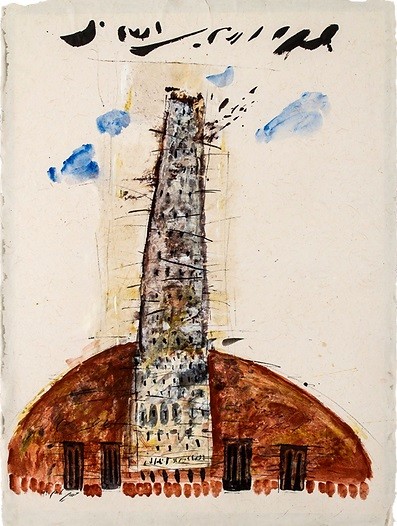Toronto,
NO. 160, Davenport Road, Toronto, ON M5R 1J2
10 December 2020 - 10 January 2021
Sahar k.Boluki Fine Art Gallery is pleased to present “Monuments,” by Mohammad Hossein Maher
What in the works of Mohammad-Hossein Maher has always impressed me is the way he makes use of color. Vivid oranges and tasteful reds sit next to tranquil shades of green and blue. These are colors that in the abstraction of abstract portraits of human beings acquire a redoubled intensity. They make us stand before a painting time and again to discover something new at every turn. But this is just a folio, a season in the oeuvre of Mr. Maher that appears in the current exhibit.
The fish appear at first to be defined more by colors than by lines. But drawings bring blood to our face as soon as we lay eyes on them. Should we have the cheek to continue beholding them, these sketches will tell us of a surgical operation on history daringly put on canvas against the well-composed and pleasant lines and marks. The fish are expressions of an audacity gone around the bend. They retell a story of anger and blood. The artist has to take refuge in myths to bring serenity to his paintings. Colors acquire an ancient aura depending on the subject matter of the paintings. As for the sketches, they appear abstract in their aesthetic manifestation and over time they seem to be free of any cruelty or fault. This is a familiar quality among all ethnic groups of the past, which seems to me to be an attempt to celebrate ancestry. And perhaps there is no need for the painter to remember his ancestors as undesirable. What’s more important is to depict them as such. Every people need to lay claim to a capital, be it economic, cultural, or historical in nature. It is a stepping stone. In visual arts, taking refuge in mythology is to forestall the dissolution of everything; if I am not mistaken, myths of Maher constitute a chapter in the four seasons of his oeuvre, and function as a distancing tool from cruelty depicted in the fish. They provide the artist with mental balance. This is why the painter chooses to represent remains of fortresses. The fourth season is detritus but it is very close to the third season, mythology, where fortresses are depicted without cavalrymen, resembling the subject matter of Iranian miniature paintings. Lonely fortresses, empty and without a human soul, point to a forgotten architecture. The imaginative creation of myths seems to be Mr. Maher’s offering. There is no longer any need for myths and no patience or need for fortresses. Thus, it is enough for these monuments to be circumscribed by these square, wooden frames to remind us that we are, after all, ancient people, and that we can’t forget the good and bad stories of our ancestors, their ugliness, and their beauty. This is a token of a realistic regard that Hossein Maher sets out to recreate. For as long as I have known him, he has striven to move from place to place, like the wave whose existence is predicated on its turbulence.
Mahmoud Dowlatabadi
